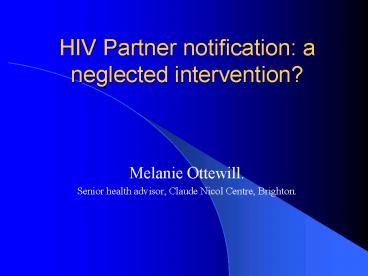HIV Partner notification: a neglected intervention - PowerPoint PPT Presentation
1 / 22
Title:
HIV Partner notification: a neglected intervention
Description:
Lack of research into HIV PN effectiveness studies outdated and inconclusive. ... 13/60 (22%) were contactable. 8/13 (61%) were contacted. 3 by provider referral. ... – PowerPoint PPT presentation
Number of Views:32
Avg rating:3.0/5.0
Title: HIV Partner notification: a neglected intervention
1
HIV Partner notification a neglected
intervention?
- Melanie Ottewill.
- Senior health advisor, Claude Nicol Centre,
Brighton.
2
Background
- Lack of research into HIV PN effectiveness
studies outdated and inconclusive. (8 out of 9
USA published studies conducted before HAART) - Most studies that exist set in USA ?comparable
populations. - Conflicting evidence regarding willingness of
patients to engage and which methods most
effective - Useful UK study (1998) by Fenton et al evaluating
HIV PN in 19 STD clinics in UK .
3
Context
- DoH (1992) guidance on HIV PN encouraged
notification and local policies. - SSHA does not set a standard for HIV PN outcome
(lack of evidence) - BASHH guidelines on HIV testing in general
medical settings does not mention PN. - Criminalisation of HIV scrutiny of PN practice
accountability. - HAART proven impact on mortality, morbidity
possibly transmission create strong impetus for
proactive PN.
4
Baseline audit - objectives
- To evaluate the effectiveness of PN in HIV new
diagnoses. - To identify differences, if any, between
different groups of patients. - To identify opportunities for improvement.
- To discuss setting a standard for HIV PN.
5
Population
- New HIV diagnoses in 2003 108.
- Sample approximately 50 of
- MSM (31)
- Black African men (5)
- Black African women (8)
- White heterosexual (3)
- N 47.
6
Diagnosis Details
- 13 had primary HIV infection 9 of whom had
primary resistance. - 7 had an AIDS diagnosis 6 of whom were
in-patients. - 23 were asymptomatic (E1).
- 4 were symptomatic (E2).
7
Partner Notification
- 43/47 (91) patients were seen by a HA.
- 15 seen once.
- 20 seen twice.
- 6 seen 3 times.
- 2 seen 4 times or more.
- PN was discussed with 36/43 (84).
- Completed PN was documented in 26/43 (60).
8
Partner Notification
- In those where PN not completed (21) PN was
raised by other HCPs in 6 (29) but was not
completed in any.
9
Regular Partners
- 36/47 (77) had regular partners.
- Range 1 to 4, total no. of partners 44.
- 11 known to be HIV
- 19/33 (58) RPs were reported to have tested
- Result known for 15/19 (79)
- 5/15 (33) tested HIV.
10
Casual Partners
- 29/47 (62) had CPs.
- Range 1 to 12, total of 60.
- 13/60 (22) were contactable.
- 8/13 (61) were contacted.
- 3 by provider referral.
- 6/8 (75) were documented to have tested.
- None were HIV.
11
Contacts per case tested
- Denominator 104 (total number of casual and
regular partners, including uncontactable). - Number tested 36 (casual and regular partners).
- Contacts screened per case 0.35
- (BASSH standard for GC or CT is 0.6).
12
Partner Notification(by stage of diagnosis)
13
Partner Notification(by risk factor)
14
PN Completed
15
Conclusions from baseline audit
- Most pts (91) seen by HA following diagnosis.
- PN discussed with 84 pts (more than 1 appt
needed). - PN outcomes documented in 60 cases (0.3 contacts
per case). - PN rarely raised by other professional groups.
- 1/3 untested RPs tested HIV (5/15). Reflects
prevalence of HIV in community.
16
Recommendations from baseline audit
- Health Advisers to keep pts on recall system
until PN completed (chlamydia/Gc). - Health Advisers to aim to see all newly diagnosed
pts at least twice. - Health Adviser to review all pt notes attending
New pt clinic to follow-up PN. - Health Adviser HIV PN guidelines to be written.
- Review 10 sets of notes every 3 mths to evaluate
progress (using a defined audit tool) . - ?Standard for HIV PN yes, after further
evaluation.
17
Mini PN Audit
- Case note review from 1/09/2004 to 31/12/2004
(recommendations implemented from August 2004). - Audit against new HA guidelines /audit tool
- Random sample of 36
18
Partner Notification2004
19
Regular Partners
- 83 (30/36) had regular partners (77)
- Total no. of partners 33 (44)
- 5(15) known to be HIV (25)
- 19/28 (68) RPs were reported to have tested
(58) - 9/19 (47) tested HIV (33)
20
Casual Partners
- 21/36 (58)had CPs (62)
- Total of 74 (60)
- Majority uncontactable as with last audit
- 5/74 (7) were documented to have tested (10)
- 3 were HIV positive 2 known HIVve (none )
21
In summary
- HIV PN guideline clarifies approach and
importance of this activity - Audit tool (evolving) useful in measuring
performance facilitating change - Reviewing 10 case notes every 3 months is not
labour intensive and facilitates ongoing change - Improvement in discussion of, completed, PN
(88 vs 55 )
22
Summary - cont
- Reduction in number of patients only seeing HA
once (16 vs 32) - High rate of RMP who tested diagnosed HIV (47
vs 33) - Contacts tested per case remains low 0.27 (0.35
previously) - Proposed outcome standard for HIV 0.3 locally
- Evidence from other clinics?

